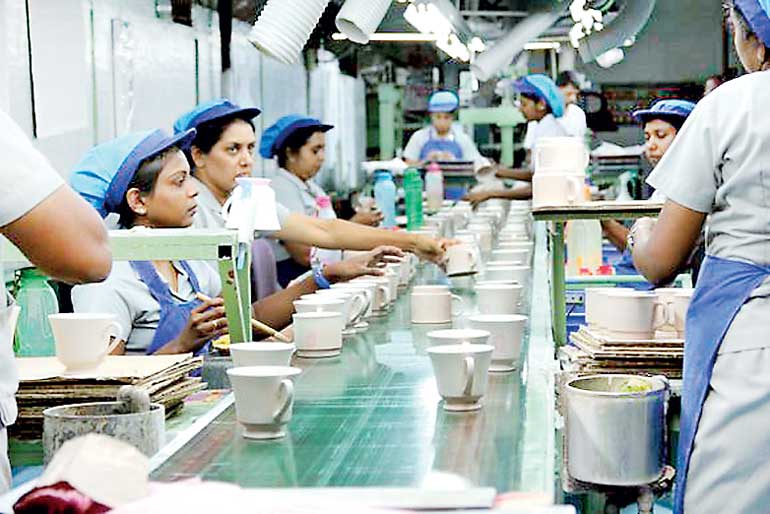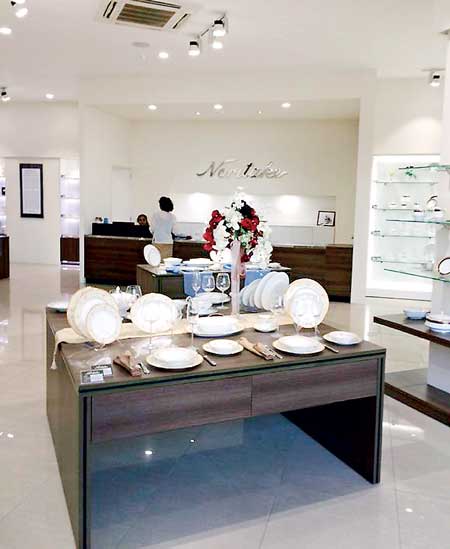Monday Dec 08, 2025
Monday Dec 08, 2025
Wednesday, 21 October 2015 00:06 - - {{hitsCtrl.values.hits}}

Many workers in the Matale factory have worked for the company for years
Japanese porcelain maker Noritake is looking to expand its presence in emerging Asian nations by leveraging its key production site in Sri Lanka as a hub to reach nearby countries. It recently opened new stores in those countries, in hopes they can compensate for the shrinking domestic market in time.
In June 2014, the Noritake tableware brand launched its “flagship in Asia” store in the Sri Lankan commercial capital of Colombo. The showroom provides a lounge for VIPs and is attracting affluent customers not only from the city but also from locations including nearby countries.
The store sells average 10 million Sri Lankan rupees ($70,896) monthly. “We are selling about three times what we expected,” said Yoshinari Shimaya, deputy chairman and managing director of the company’s local subsidiary, Noritake Lanka Porcelain.
The small island nation in the Indian Ocean attracted more than 1.5 million tourists in 2014 from countries including India and China. This popularity can help the brand to be widely recognized in the region, Shimaya said.
The company recently opened two stores in India, in the northern province of Punjab in March and in Bangalore in southern India in June. The company’s sales reps there are trying to expand sales channels to meet growing demand for tableware for weddings and marriages in the country.
In China, the company opened a new store in February in the Shanghai New World Daimaru Department Store, a new landmark in the city. The brand also plans to promote its products through the Weibo microblogging website.
Noritake in 1910s began exporting its high-end tableware and other chinaware to the U.S., which made it a leading luxury tableware brand in Japan. Noritake tableware is currently sold in more than 60 countries and regions worldwide.
Changing market
However, people’s lifestyles and eating habits have changed over time. Today, people are increasingly dining out, and families have decreased in size, so they no longer have to buy a full set of luxury tableware any more for big family dinner occasions.
The company’s sales of tableware have shrunk to one-fifth of their peak. Their position as the company’s main contributor of revenues has been replaced by industrial materials, such as grinding and polishing tools.
Even so, the established tableware brand is still a core part of the company, said Yoshitaka Mabuchi, an executive in charge of the tableware business. In the three-year business plan to fiscal 2015, the company has laid out a target of raising the overseas sales ratio to roughly 60% of the tableware business. The brand sees great potential in emerging Asian economies where middle-class and affluent populations are growing.
Other renowned chinaware brands, such as Royal Copenhagen of Denmark and Wedgwood from Britain, also began focusing on the Asian market. But Noritake has a strong advantage because it has operated its own factory for more than 40 years in Sri Lanka.
A three-hour drive northeast of Colombo is the company’s main factory in the town of Matale. The factory, capable of producing 650,000 pieces a month, provides about 90% of the brand’s tableware.
Noritake launched the factory in 1973, attracted by the inexpensive labor there. The company has shut down other production sites overseas while domestic production has been aggregated to a site in Imari, Saga Prefecture, in the Kyushu region. The Sri Lankan factory now serves as the key location of the brand.
Wages in Sri Lanka are half to a third of those in China. About 70% of Noritake’s employees there have worked more than 10 years for the company. Shimaya appreciates the earnest nature of the local workers.
Having its own factory also helps the brand maintain the high quality of the company’s products. In order to enhance the production quality and to promote the philosophy of the brand, based on a delicate Japanese sense of beauty, the company introduced a program to educate local trainers in 2013.
Today, some 70 trainers, who have learned the know-how and manufacturing procedures through the program, are overseeing the production process in the factory, aiming to improve the quality and productivity there.
In an attempt to shorten the time needed for product development, the factory also plans to introduce computer-aided designing and manufacturing system by the end of this year. The factory has been using drawings and moldings prepared in Japan, but the new system will allow the production site to respond flexibly to market needs, which vary depending on countries and seasons.
Sri Lanka has a geographical advantage, too. The island’s position in the center of the Indian Ocean, and its developed port infrastructure, play a key role in the distribution of goods. It also offers lower shipping costs than nearby nations. These features can help the company to expand its supply chain not only to other part of Asia, but to the Middle East and Africa as well.